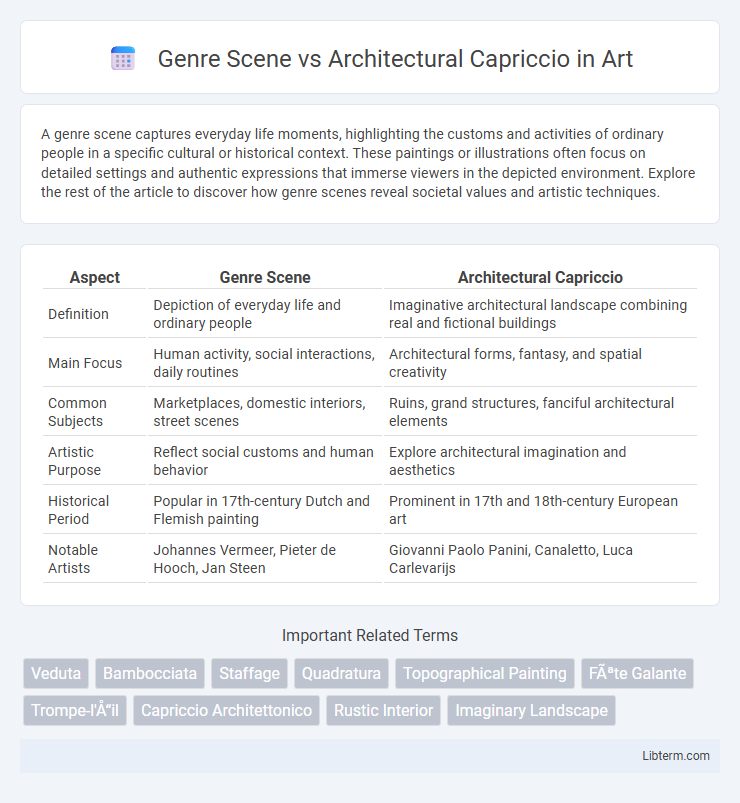A genre scene captures everyday life moments, highlighting the customs and activities of ordinary people in a specific cultural or historical context. These paintings or illustrations often focus on detailed settings and authentic expressions that immerse viewers in the depicted environment. Explore the rest of the article to discover how genre scenes reveal societal values and artistic techniques.
Table of Comparison
| Aspect | Genre Scene | Architectural Capriccio |
|---|---|---|
| Definition | Depiction of everyday life and ordinary people | Imaginative architectural landscape combining real and fictional buildings |
| Main Focus | Human activity, social interactions, daily routines | Architectural forms, fantasy, and spatial creativity |
| Common Subjects | Marketplaces, domestic interiors, street scenes | Ruins, grand structures, fanciful architectural elements |
| Artistic Purpose | Reflect social customs and human behavior | Explore architectural imagination and aesthetics |
| Historical Period | Popular in 17th-century Dutch and Flemish painting | Prominent in 17th and 18th-century European art |
| Notable Artists | Johannes Vermeer, Pieter de Hooch, Jan Steen | Giovanni Paolo Panini, Canaletto, Luca Carlevarijs |
Understanding Genre Scene: Definition and Origins
Genre scenes depict everyday life and ordinary people engaged in common activities, originating in 17th-century Dutch and Flemish painting as a reflection of social realities and domestic settings. These artworks emphasize narrative storytelling and character interaction, offering insights into cultural customs and societal norms. Contrastingly, architectural capriccios are imaginative compositions where architects combine real and fantastical buildings, prioritizing creative expression over realistic depiction.
Architectural Capriccio: Historical Context and Development
Architectural Capriccio emerged during the Renaissance and Baroque periods as an imaginative genre featuring fantastical buildings and ruins, diverging from the realistic portrayal in Genre Scenes. Artists like Giovanni Paolo Panini popularized this style by blending real and invented architectural elements to evoke a dramatic and picturesque atmosphere. This approach reflects the era's fascination with antiquity, romantic decay, and the artistic exploration of idealized urban landscapes.
Key Characteristics of Genre Scenes
Genre scenes depict everyday life with detailed representations of ordinary people engaged in common activities, emphasizing realism and social context. These paintings often feature intimate interiors or outdoor settings, capturing moments of daily routine, work, leisure, and interaction. Unlike architectural capriccios, which focus on imaginative and fantastical buildings, genre scenes prioritize human narratives and cultural authenticity.
Distinctive Features of Architectural Capriccio
Architectural capriccio is characterized by imaginative and fantastical architectural compositions that blend real and invented structures, often emphasizing ruins and classical elements in dramatic landscapes. Unlike genre scenes, which depict everyday life and social activities with a focus on narrative realism, architectural capriccios prioritize artistic creativity, architectural detail, and atmospheric effects over storytelling. The distinctive features include exaggerated perspectives, elaborate ruins, and a harmonious fusion of diverse architectural styles creating a dreamlike visual experience.
Subject Matter: Everyday Life vs. Imaginative Architecture
Genre scenes depict everyday life, capturing ordinary people engaged in common activities such as market visits, family gatherings, or work routines, offering a realistic glimpse into social contexts. Architectural capriccios feature imaginative and fantastical architectural designs that combine real and fictional elements, emphasizing artistic creativity over realism. While genre scenes focus on human interaction and social narratives, architectural capriccios highlight architectural fantasy and visual innovation.
Artistic Techniques and Composition Styles
Genre scenes emphasize everyday life through realistic depiction, utilizing naturalistic lighting and intimate compositions that highlight human interaction and emotion. Architectural capriccios rely on imaginative architectural elements, combining various classical and fantastical structures in exaggerated perspectives to create dramatic spatial depth. Techniques in capriccios often include intricate detailing and exaggerated scale to evoke grandeur, contrasting with the grounded, proportionate forms and softer palettes typical of genre scenes.
Influential Artists and Masterpieces
Genre scenes, exemplified by artists like Jan Vermeer and Jean-Baptiste-Simeon Chardin, depict everyday life with intimate detail and emotional depth, as seen in Vermeer's "The Milkmaid." Architectural capriccios, on the other hand, are imaginative combinations of architectural elements, pioneered by Giovanni Paolo Panini and Canaletto, whose "Roman Capriccio" showcases elaborate, fantastical structures. The distinct focus on human activity in genre scenes contrasts with the grand, often surreal cityscapes in architectural capriccios, highlighting divergent artistic intentions and influences.
Symbolism and Narrative Elements
Genre scenes depict everyday life with detailed storytelling, emphasizing symbolic objects that reveal cultural and social narratives, such as utensils symbolizing domesticity or gestures indicating social status. Architectural capriccios blend real and imagined structures, using symbolic elements like ruins or grandiose arches to evoke themes of decay, nostalgia, or idealized grandeur, creating a narrative through spatial imagination. Both genres employ symbolism to communicate deeper meanings, but while genre scenes focus on human interaction and daily existence, architectural capriccios explore abstract concepts through architectural forms.
Cultural Significance and Audience Reception
Genre scenes capture everyday life moments, reflecting societal norms and cultural values that resonate deeply with audiences by offering relatable and immersive narratives. Architectural capriccios present imaginative and fantastical cityscapes, blending real and invented structures to evoke wonder and intellectual engagement, appealing to viewers fascinated by artistic creativity and historical references. Both genres hold cultural significance by preserving different aspects of human experience--mundane daily activities in genre scenes and visionary architectural fantasies in capriccios--shaping diverse reception based on viewers' interests in reality or imagination.
Contemporary Interpretations and Legacy
Contemporary interpretations of genre scenes emphasize everyday human interactions, blending realism with symbolic undertones to reflect modern societal narratives. Architectural capriccio in contemporary art reimagines classical ruins and fantastical structures, merging historical motifs with digital techniques to challenge perceptions of space and memory. The legacy of both genres endures through their influence on multidisciplinary practices, inspiring artists to explore the intersection of reality and imagination in urban and social contexts.
Genre Scene Infographic

 libterm.com
libterm.com